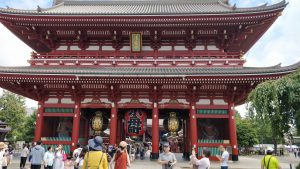En la ciudad hiperactiva de Tokio; con su spaghetti de subtes modernos y trafico peatonal pesado, hay todavia un estrato de cultura tradicional oriental que actua como columna de la eficiencia Japonesa. Este estrato se manifiesta en forma de religion, y miles de Japoneses y turistas llenan (la mayor parte de los dias) los santuarios sintoistas, para dejar al alma descansar de la ciudad.
Visitamos hoy el santuario Kaminarimon, que es el mas antiguo de la ciudad de Tokio. Aca vimos a Japon desde abajo.
En contraste, para poder procesar la magnitud de la eficiencia e hiperactividad de la que hable antes, hace falta ver a Japon desde arriba. Mas especificamente, 350 metros. Para lograr esto, visitamos el «Skytree» una torre de observacion moderna que deja todas las bocas abiertas.
In the hiperactivity of Tokyo city; with its modern subway spaghetti and heavy pedestrian traffic, there still is a stratus of traditional oriental culture that acts as a column of Japanese efficiency. This stratus is shown as religion, and thousands of Japaneses and and tourists fill (most days) the shinto shrines, to let their souls breathe from the big city.
Today we visited the Kaminarimon shrine, which is the oldest shrine in Tokyo. Here we appreciated Japan from below.
In contrast, in order to process the magnitude of the forementioned efficiency and hyperactivity, its necessary to see Japan from above. More specifically, 350 metres. To achieve this, we visited the «Skytree», an observation deck that leaves everyone speechless.










